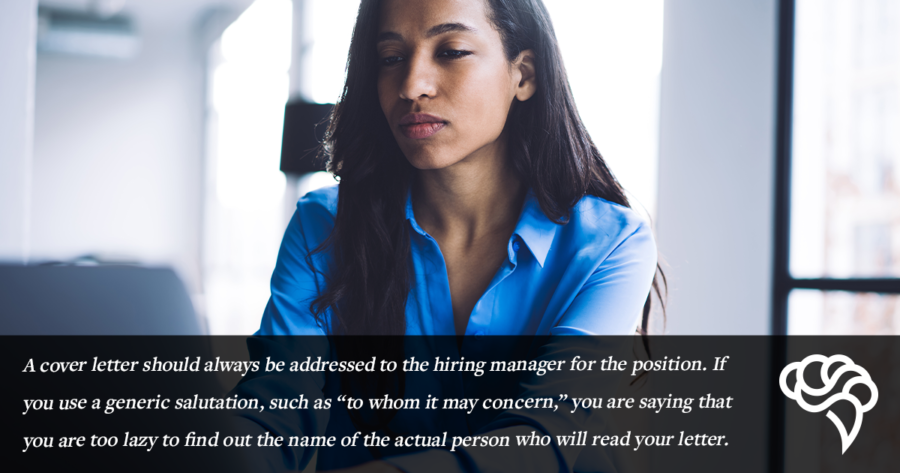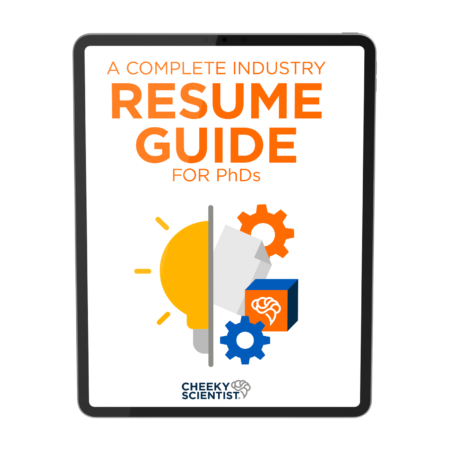How To Write A Convincing Cover Letter In 3 Steps

Setting up a job search application can be time consuming.
Especially if you have set up the right job search strategy and are applying to several positions at the same time.
This leads many PhDs to try to cut out steps of the job application that seem dispensable. For example, the cover letter if the job posting doesn’t specifically asks for one.
This is a misconception, you should always include a cover letter with your job applications.
How formal the cover letter is will depend on the situation, but taking the time to introduce yourself and your candidacy will separate you from other job candidates and show decision makers that you are a person, not just a resume.
I was recently talking to a member who transitioned a couple of months ago and has now participated in hiring committees for their company. This is what they had to share:
Although not all hiring managers read cover letters or consider them as part of their decision procress, it’s always better to include one with the application.
For those who care about it, receiving a resume without a cover letter means the application goes into the trash and many hiring managers like to have your point of view of what you bring to the table.
So, when in doubt, always submit a cover letter, worst case scenario no one will read it, but it can give you a unique opportunity to to highlight why you are a better fit for the role when compared to other applicants.
A Convincing Cover Letter Will Get You A Phone Screen
There’s a common misconception that you either need a very formal cover letter or no cover letter at all. You always need a cover letter, even if it’s just an email presenting your candidacy.
A career builder survey of 1,500 recruiters and hiring managers found that 29% of employers will reject an application if it doesn’t have a cover letter.
It’s also important to spend time customizing your cover letter and making sure it’s well written.
Forbes reported that 48% of cover letters are rejected if they are not customized and 49% are rejected if they have grammar mistakes or typos. So, take the time to make a well-crafted cover letter.
Your goal with the cover letter should be to convince the reader that you can accomplish their goals. In other words, that you are the best fit for their open position and that you can bring value to the company.
There are three ways to submit a cover letter.
The first and most formal one is as a separate document, structured as an actual letter in PDF format. This is ideal if the position specifically asks for a cover letter.
The second option is to send it in the same document as your resume. In this case, the cover letter would be the first page of a three-page document.
You can do that if you are applying through a job portal that only allows you to upload one file when submitting your application.
Finally, it can be the body of an email with your resume attached. This will be the more likely scenario if you have been networking and generating referrals.
You will probably send an email to someone you were introduced to after an informational interview.

3 Steps To Writing A Convincing Cover Letter
Now that you know that a cover letter is important, you’re probably wondering how you write one.
First, it must be a standard business letter format, and this is country specific. For Australia, UK, and Europe, it should be A4 and for the United States, it should be US letter.
Second, it should be only one page with three short paragraphs. If it’s longer, you need to cut it down.
Let’s take a look at the information you should include in each paragraph of your cover letter.
Start by addressing your cover letter
The first paragraph of your cover letter should only be one sentence, two at the most.
It should be addressed to the right person and it should introduce your referral and express your enthusiasm about applying for the position and working at the company.
The first paragraph might be short, but it contains a lot of crucial information when it comes to establishing your credibility.
It should always be addressed to the hiring manager for the position. If you use a generic salutation, such as “to whom it may concern,” you are saying that you are too lazy to find out the name of the actual person who will read your letter.
There are different strategies you can use to find the name of the hiring manager.
The first one is to call the company. Nearly every company that you could apply to for a job can be found online and they will have a contact number.
Ask to talk to the hiring manager responsible for the position at hand. You should at least get a lead on who is responsible for the hiring process.
The second way you can find the name of a hiring manager is through networking. This is the ideal scenario.
You want to network and set up informational interviews with people working at your company or companies of interest.
If you don’t know anybody at your company of interest, find a secondary or tertiary connection and ask for an introduction.
This will ensure that you have insider information to figure out who is the person responsible for the job posting.
You can also find the name of a hiring manager by reading the job posting carefully.
It is often the case that when job candidates read a job posting, they only skimm it to find the relevant skills for the position and they don’t look for the contact information of the person posting the job, but it’s there.
Finally, you can do an online search to find the hiring manager or person posting a job advert.
Once you address your cover letter, you need to add the name and title of the person who referred you for the job. This is probably someone you had an informational interview with and let you know about the position.
This information is very important as it will help you create report with the hiring manager by showing there is someone working at their company – someone they probably know – who is willing to vouch for you.
Finally, you want to make it clear that you’re applying for a specific position. Very often, your cover letter will be the first thing that a decision maker reads. So, the first paragraph is a great place to introduce yourself.
Below is an example of what the first paragraph of a cover letter should look like:
[Name], [title] at [company]
[Name of your referral, title, and company] encouraged me to apply for [open position]. I am writing in response to their recommendation because I think I would be a great fit for this position and I am very interested in the work being done at [company name].
In the next paragraphs, you will explain why you are such a good fit for the position at hand.
Continue by explaining why you are a good fit
The aim of the second paragraph is to show how your experience matches the role you’re applying to.
This paragraph should focus on how your previous experience will allow you to achieve each of the points covered in the job description. Leave out any information that is not directly related to that specific job.
You can present this information in two ways. The more formal is by writing a conversational paragraph where you explain how your previous experience relates to the needs of the employer.
Alternatively, you can skip the second paragraph altogether and replace it with a two-column table. The left column should list the requirements of the job description and the right column should list your qualifications and previous experience.
This is called the T-format cover letter and it gives you a good opportunity to visually show why you are the best fit for the position.

Conclude by highlighting the value you bring to the table
The third and final paragraph should focus on the value you’re bringing to the company.
While the second paragraph should focus on your experience and your technical expertise, the third paragraph should focus on your tranferable skills and why you are a good fit for the company culture.
Focusing on your transferable skills and how the company culture matches your values will show that you can contribute to the company and will adapt to their work environment. In other words, that you will be a good fit in all fronts, not just a capable employee.
Recruiters and hiring managers want to hire candidates who align with the company culture. So, this is a great way to end your cover letter.
Concluding Remarks
Many PhDs think that cover letters are optional or a thing of the past, but in reality they are an important part of a job application as they provide an unique opportunity to differentiate yourself and show why you are the right candidate for the position. A cover letter should only be one page and contain three paragraphs. The first paragraph should be addressed to an actual person, introduce your referral, and make it clear that you want to apply for a specific position. The second paragraph should show how your previous experience and technical skills match the job description, showing that you would be a capable candidate for the role. Finally, the third paragraph should focus on your tranferable skills and how your values align with the company culture, showing that you would add value to the company if they hire you. Make sure to always submit a targeted cover letter so you can make a great first impression.
If you’re ready to start your transition into industry, you can apply to book a free Transition Call with our founder Isaiah Hankel, PhD or one of our Transition Specialists. Apply to book a Transition Call here.

ABOUT ISAIAH HANKEL, PHD
CEO, CHEEKY SCIENTIST & CAREER SUCCESS MENTOR
Dr. Isaiah Hankel is the Founder and CEO of Cheeky Scientist. His articles, podcasts and trainings are consumed annually by millions of PhDs and other professionals in hundreds of different countries. He has helped professionals transition into top companies like Pfizer, Tesla, Amazon, Pearson, Google, Apple, Intel, Dow Chemical, BASF, Merck, Genentech, Home Depot, Nestle, Hilton, SpaceX, Syngenta, the CDC, UN and Ford Foundation.
Dr. Hankel has published 3X bestselling books and his latest book, The Power of a PhD, debuted on the Barnes & Noble bestseller list. His methods for getting PhDs hired have been featured in the Harvard Business Review, Nature, Forbes, The Guardian, Fast Company, Entrepreneur Magazine and Success Magazine.
More Written by Isaiah Hankel, PhD































